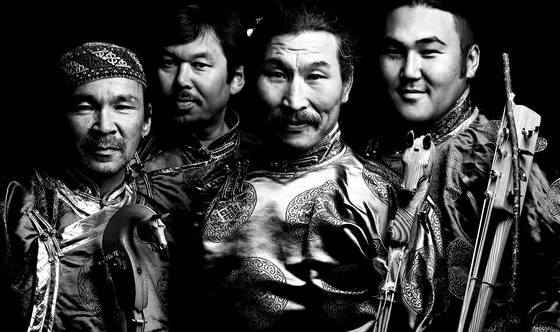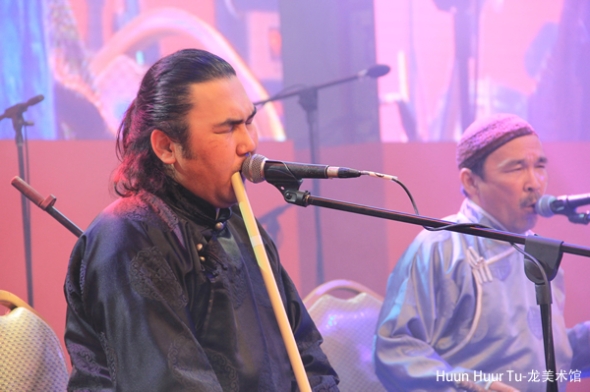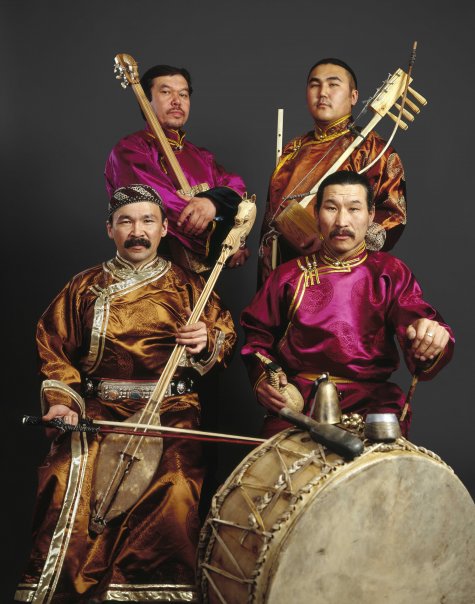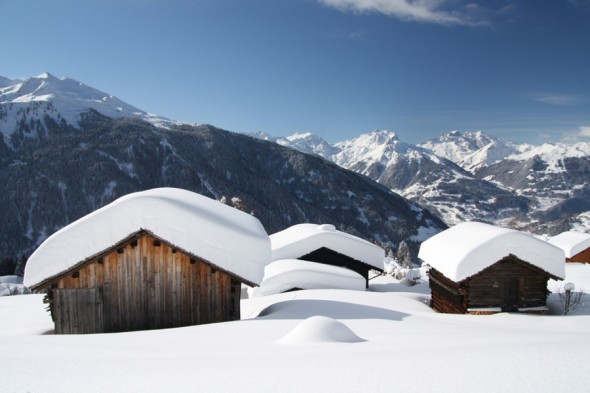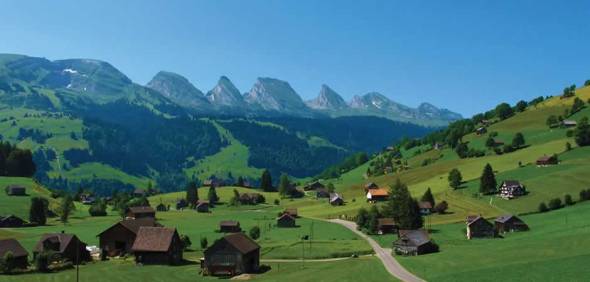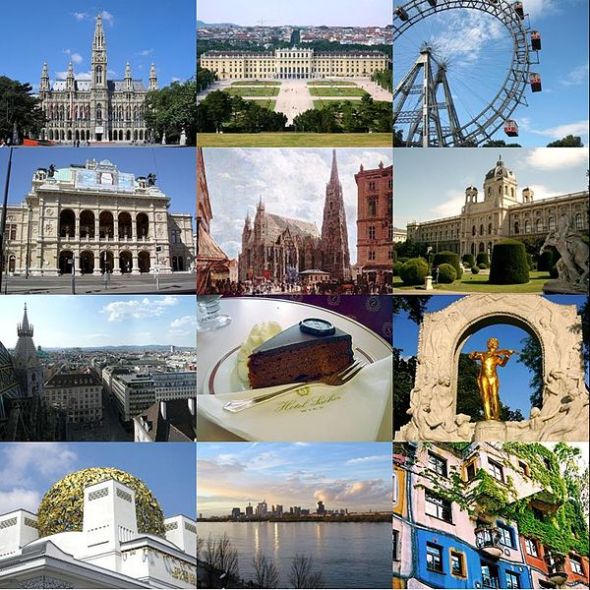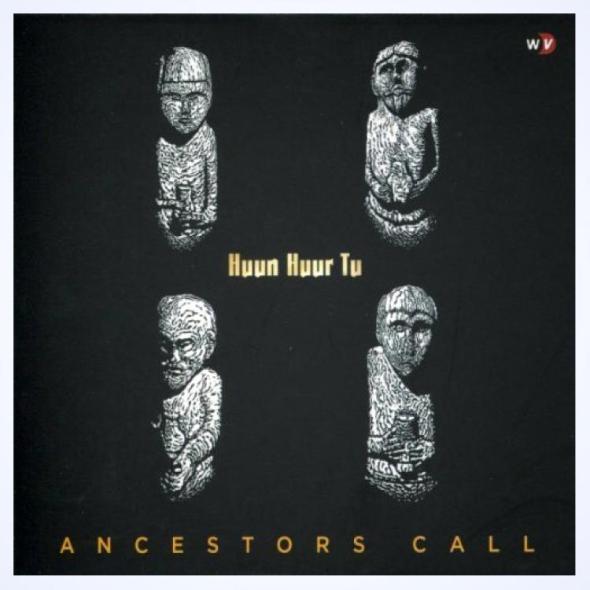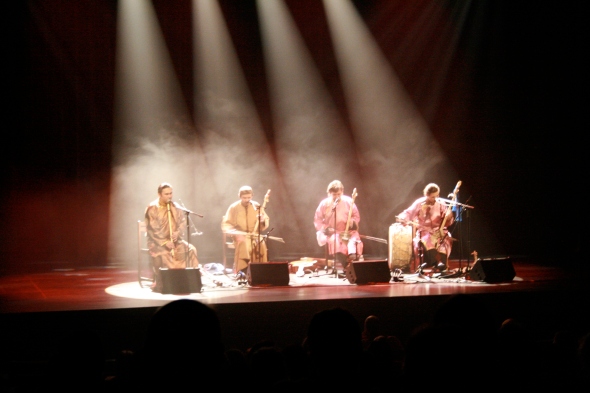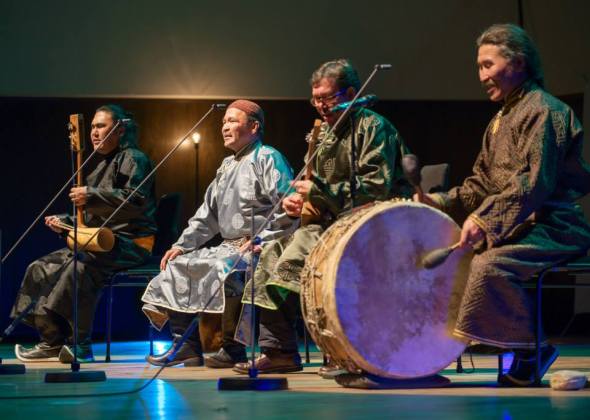Huun-Huur-Tu (Tuvan: Хүн Хүртү Khün Khürtü, Russian: Хуун-Хуур-Ту) is a music group from Tuva, a Russian Federation republic situated on the Mongolian border.
The most distinctive characteristic of Huun Huur Tu’s music is throat singing, in which the singers sing both the note (drone) and the drone’s overtone(s), thus producing two or three notes simultaneously. The overtone may sound like a flute, whistle or bird, but is actually solely a product of the human voice.
The group primarily uses native Tuvan instruments such as the igil, khomus (Tuvan jaw harp), doshpuluur, and dünggür (shaman drum). However, in recent years, the group has begun to selectively incorporate western instruments, such as the guitar. While the thrust of Huun Huur Tu’s music is fundamentally indigenous Tuvan folk music, they also experiment with incorporating not only Western instruments, but electronic music as well.
Latest
Huun-Huur-Tu
Huun Huur Tu will have concert at Fuji Rock Festival in Japan
Dates
July 25 (Fri), 26 (Sat), 27 (Sun) 2014
Place:
Naeba Ski Resort, Yuzawa-machi, Niigata, JAPAN
Tickets
3-day tickets:
¥44,000
—> Special Advance Ticketing Discount ¥40,900
1-day tickets:
¥18,300 (limited to 10,000/day)
—> Special Advance Ticketing Discount ¥17,200
http://fujirock-eng.com/index.html
Huun-Huur-Tu will have a concert at “Shanghai World Music Festival” 15October,2014
Call for performers/performing groups in the Shanghai World Music Festival 2014.
The Shanghai World Music Festival 2014 will be held in October 2014. All performers and performing groups specializing in World Music, Folk Music or Ethnic Music are welcome to submit a proposal to perform in this festival. Interested parties please contact the Shanghai World Music Festival organizing committee at hm@hmculture.com or lijiang@hmculture.com. Do give us a biography of yourself or your group, give us your contact, let us know what you do, as well as what items you would like to perform. Do also provide us with recordings or links to recordings, video or audio. Shortlisted applicants will be notified either by email or phone. Thank you.
World music is an art that transcends peoples and cultures. It is formed outside the Western Classical tradition; from the essence of the various musics around the world, forged from the spirit of traditional music, the context of the music of the folk, and the zeitgeist of modern music and musical creativity. It blends tradition and composition from the various races and creeds around the world, and is an artistic microcosm, which celebrates the diversity we have in our world. It also brings together the various intangible cultural heritage items of different parts of the world and introduces them to an audience that would not otherwise know them.
In the West, World music has already had a wide outreach, not including a myriad of audiences, but also the advocacy of UNESCO through its listing of some performance traditions as Intangible Cultural Heritage items. Hence there are frequent and regular events featuring world music; recordings are also easily available.
World music can be said to be the genre best suited for China to show its uniqueness to the world, yet accept the challenges of globalisation. In the words of Zhang Pei-ren, the godfather of Taiwanese rock music, “World music can rock the audience beyond their wildest imagination, hence we must greatly promote it!”see more about festival: http://worldmusicshanghai.com/
The world-class khoomei group who links prairie and soul: Huun-Huur-Tu
Huun-Huur-Tu is the premier Tuvan musical group and the world’s top throat-singing ensemble. Huun-Huur-Tu is described as the most natural sound to the deep soul. Huun-Huur-Tu has cooperated with world-class musicians like Frank Zappa and Ry Cooder. Huun-Huur-Tu has successfully toured all over the world since it was created 20 years ago.
Watch Huun-Huur-Tu at Concert 2013
Huun-Huur-Tu means the vertical separation of light rays that you often see out on the grasslands just after sunrise or just before sunset, which matches very well with the spirit of the group. As early as 1993, Huun-Huur-Tu toured in the US, causing an upsurge of khoomei there. In 1999, Huun-Huur-Tu cooperated with some scholars of ethnic anthropology including Michael Edgerton and Ted Levin. Their cooperation gave birth to some important works of Central Asian ethnology. Thanks to the efforts of these musicians and scholars, “khoomei center” was founded in America and related organizations have been founded in Europe to protect khoomei.
Huun-Huur-Tu will have a concert at PLATONOV VORONEZH FESTIVAL on 12june
Huun-Huur-Tu,Russia
Tuvan throat singing ‘xoomei’
Philharmonic HallInternational Platonov Arts Festival, named after the greatest Russian writer of the twentieth century Andrey Platonov, has been held in Voronezh since June 2011. Created under the direct patronage of the Governor of Voronezh Region Alexey Gordeev, the festival has become the major cultural project in the region and one of the dynamically developing multidiscipline festivals in Russia. It provides a unique opportunity to residents of Voronezh and of the surrounding areas to enjoy the outstanding creative achievements in various art forms. It is a bright new stage in the development of culture of Voronezh region, which is intended to approve Voronezh as one of the leading centers of the Russian culture.
On the official Day of Russia the most famous internationally acknowledged ethno-music band of the former Soviet Union, throat singers of Tuva, perform in Voronezh.
The republic Tuva as a part of Russian Federation is located in southern Siberia and borders on Altai and Mongolia, Forests, mountains, and steppe make up a large part of the geography.
The members of Huun-Huur-Tu and other Tuvan throat singers can produce more than one pitch simultaneously while singing. No one in the rest of the world is entirely sure how they do it, but most Tuvans learn the skill as children. It involves singing one tone normally while amplifying the tone’s harmonics—the quieter, higher tones that are part of any sounding pitch (heard, for example, when the lip of a bottle is blown hard)—with manipulations of the larynx, lips, tongue, jaw, and soft palate.
Huun-Huur-Tu’s members can even produce short melodies in one “voice” along with single notes.
The Tuvan acoustic quartet Huun Huur Tu proves that Tuvan music can take plenty of intelligent innovation. Using traditional instruments and drawing subtly on 20th-century composers, funky rhythms, and the palette of electronica, Huun Huur Tu transform ancient songs into complex acoustic compositions.
Since 1993 the group made repeated tours of the United States and also performed in Europe, Japan, and (in 1999) Australia. 2000 the band performed life in the opening and closing of the BBC Life Music festival. 2012 the band was nominated to the BBC World Music Award.“A single voice can sound like three, and the overlapping tones are almost deceptive in their depth and complexity, creating the illusion that there is actually more going on than first meets the ear. This is not particularly uptempo music, but it is intensely spiritual.”
THE CHICAGO TRIBUNE
“The Tuvans will ride into your brain and leave hoofprints up and down your spine.”
THE SAN FRANCISCO BAY GUARDIAN
“A rustic joyousness and unadulterated expressiveness come out of these musicians.”
JAZZ TIMES
“The members of Huun-Huur-Tu are perhaps the best known practitioners (of throat singing) and accompany themselves on all manner of strange and wonderful instruments… The resulting sound is as compelling as a wild gallop across the steppes.”
THE OREGONIAN (Portland)MUSIC PROGRAM:http://en.platonovfest.com/musica
Radik Tyulyush Solo Album CHALAMA (Only traditional Tuvan instruments was used.)
“CHALAMA” is the second Radik’s solo album. Chalama is a respect and tribute for Spirits of the Land.This album is a tribute for World Cultural Tree.
It contains traditional Tuvan tunes and songs with Radik’s arrangement and songs written by him and his relatives.
Only traditional Tuvan instruments was used.
RADİK TYULYUSH: Vocal, Throat Singing, Igil, Byzaanchy, Shoor, Doshpuluur, Chadagan, Percussion, Deer Decoy.
Sound recording by Sergey Kalugin,Alexandr Kostarev, Alexey “Mapa” Ivanow.
Mixing,mastering and keyboard (5,9,10) by Alexey “Mapa” Ivanow.
Sound effect by Sergey Kalugin, Alexey “Mapa” Ivanow.
Sound producing by Valery Atanova and Radik Tyulyush.
Executive producing by Valery Atanova.
Design by Natalia Atanova.
Color photos by Semen Amanatov.
Watercolor images by Valery Atanova.
CHALAMA Web-Site:http://chalama.kroogi.com/en/download/2831022-Chalama.html
See videos and more: http://chalama.wordpress.com/
Huun-Huur-Tu Saryglarlar ( Concert in Nice/France 24.05.2014 )
This song about so beautiful princess from ancient times.
Huun-Huur-Tu Concert in Nice/France 24.05.2014 ( Kozhamyk )
Lyrics in English
Three of us, four of us,
But we’re strong as thirty.
What is thirty against us?!
They won’t hold against the three of us.
Four of us, five of us,
But we’re strong as forty.
What is forty against us?!
They won’t hold up against the four of us.
Five of us, six of us,
But we’re strong as fifty.
What is fifty against us?!
They won’t hold up against the five of us.
Six of us, Seven of us,
But we’re strong as sixty.
What is sixty against us?!
They won’t hold up against the six of us.
Huun-Huur-Tu Concert in MONTAFON/Austria 04.07.2014
04.07.2014 MONTAFON/Austria
Venue:Montafoner Sommer 2014
KONTAKT
MONTAFONER SOMMER
Montafonerstraße 21
6780 Schruns
T: +43 (0) 5556 722 53 53
M: karin.sattler@montafon.at
http://stand-montafon.at/montafoner-sommer/programm-2011/huun-huur-tu
Huun-Huur-Tu concert in TOGGENBURG/Switzerland 30May,2014
30.05.2014 TOGGENBURG/Switzerland
Venue:KlangWelt Festival http://www.klangwelten.com/festival/
Huun-Huur-Tu (A-Shoo-De-Ke-Yo Lyrics in English)
When my trotting dun is trotting
the fog on the ground clears up
When the eloquent girl manifests herself
The Seven Stars conjoin
My sweetheart’s two eyes
are like the stars that rise late
Her coarse braid
is like the cedar of my taiga pasture
When my ambling dun is ambling
the first fog clears up
When my witty dear manifests herself
The first stars conjoin
Its children are bold,
cheerful and merry, deng-deng
Its peoples are free
it is our Tuva, deng-deng
My young beloved’s two eyes
are like the stars that shine in the evening
Her braid born in autumn
is like some land’s cedar
http://www.tyvawiki.org/wiki/Aa-Shuu-Dekei-Oo
Huun-Huur-Tu – Eki Attar (Good Horses- Lyrics in English)
Good Horses
On the swift steed’s head
Bridle and bit are rinkling-rinkling
Remembering the beloved above all
My heart is beating pit-a-pat
On my good bay horse’s head
Saddle and rein are rinkling-rinkling
On my sweetheart’s braid
Her braid ornament is swaying-swaying
Trotting up the river Khemchik
Such is the pace of the arched dun horse
Always coming when evening falls
Such is the habit of my young love
Trotting clip-clop clip-clop
It is the trot of my dark-bay horse
Always smiling softly
Such is the habit of my sweet friend
The silver bridle on my horse’s head
Is it enviable, brother-in-law?
Your lambkin staying with me
Is she desirable, brother-in-law?
The golden saddle, rein, and bit
Are they enviable, brother-in-law?
Your precious staying with me
Is she desirable, brother-in-law?
On the shy colt’s head
Bit and rings are rinkling-rinkling
On my young love’s braid
Her braid ornament is swaying-swaying
I long to ride my skewbald horse
On whose flank a mark is branded
I long to meet the beloved girl
On whose fingers rings are stuck
Read more Translation : http://www.tyvawiki.org/wiki/Eki_Attar
Huun-Huur-Tu Ödügen Tayga ( Lyrics in Tuvan,Turkish,English)
Ödügen Tayga
Ödügen Tayga čurttug-la men
Öleŋ sigen čïttïg-la men
Čalïm tayga čurttug-la men
Šaanak sigen čïttïg-la men
Eder čarïŋ munup algaš
Eliiŋ budun dergilep kel
Mïndï čarïŋ munup algaš
Mïygaaŋ budun dergilep kel
ÖTÜKEN TAYGASI(Ormanı)
Ötüken Taygası, yurtlarım ben
Islak çimen koklarım ben
Çalımlı tayga, yurtlarım ben.
Ardıç, çimen koklarım ben.
Karacanın altına bağlayıp eğeri
Elini ayağına derleyip gel
Geyik altına bağlayıp eğeri
Eğerini ayağına derleyip gel
ÖDÜGEN TAYGA
The Ödügen Tayga is my home
I smell the sedge and grass
The rocky tayga is my home
I smell the junipers and grass
Come, riding your reindeer stag
The feet of the roe doe tied to the saddle
Come, riding your reindeer hind
The feet of the maral doe tied to the saddle
RUMI FESTIVAL 2013 – HUUN HUUR TU (OSLO)
HUUN HUUR TU
RUMI FESTIVAL 2013 RIKSSCENEN OSLO-NORWAY
Kaigal-Ool Khovalyg (doshpuluur, igil), Radik Tyulyush (byzaanchy, fløyte), Sayan Bapa (doshpuluur, igil, gitar), Alexey Saryglar (duiuglar, igil, tromme, perkusjon)
Ancestors Call-To preview a song, mouse over the title and click Play. Open iTunes to buy and download music.
Album Review
Many people discovered the strange Central Asian magic of throat singing via Huun-Huur Tu. It’s not confined to Tuva, but that’s the home of these guys, one they mix with traditional instruments. In their now-lengthy career, they’ve tried many things (their last album was mixed with ambient electronica) but this time they’re very much back to their roots, and it serves them well. Although best known for their throat singing, which does feature on several cuts here including the short but eerily beautiful “Prayer,” it’s only one weapon in their arsenal. They’re also very adept musicians on their respective instruments and good singers in every way, and they demonstrate all the facets of their talent. It’s music that can seem alien (especially the throat singing) but there’s a deep beauty to it all. For all that it sounds ancient, inspired by the rhythms of horse’s hooves on the steppes, this is modern music, inspired by the tradition. It’s a wonderful soundscape.
Customer Reviews
Incredible sounds from humans
by WTF!!!!!!!!!
I’ve never realized such singing existed until I came across this band. I drift off into another realm when I listen to them.
View in iTunes :https://itunes.apple.com/us/album/ancestors-call/id586358851
Huun-Huur-Tu Konzert Offenburg/Deutschland
Datum: 26.05.2014
Zeit: 20:00 Uhr Altersbeschränkungen: All Ages
Offenburg/Deutschland
HUUN-HUUR-TU
Archaische Stimmwunder aus Tuva
Sasha Bapa, sein Bruder Sayan und zwei weitere Musiker, Kaigal-ool Khovalyg and Albert Kuvezin gründeten HUUN-HUUR-TU 1992, um sich auf die Präsentation von alten und vergessenen Liedern zu konzentrieren, wie Sasha es ausdrückt.
1993 spielte das Ensemble Huun-Huur-Tu erstmals in Amerika und erzielte binnen kurzer Zeit überwältigende Erfolge. Ihr “Khoomei” oder “Throat singing” – wie die Amerikaner sagen, der Obertongesang ist eine der faszinierendsten Vokaltechniken der Welt. Schnell erreichte das Ensemble einen “Kultstatus” in der neuen Welt, veröffentlichte dort mittlerweile sechs CD’s und erfreut sich weiter wachsender Popularität. Die Kultur der Tuvenen ist der mongolischen verwandt und spiegelt den Respekt vor der Natur wieder.
Huun-Huur-Tu spielte im Amerika u. a. zusammen mit dem Kronos Quartet, Frank Zappa – dem sie das Lied “Ching Söörtükchülerining Yryzy” (Song of the Caravan Drivers) gewidmet haben – , den Chieftains und L. Shankar.
Huun-Huur-Tu Stil
Unüberhörbar gibt es einen rituellen Charakter in dieser Musik, aber alle meditativen Tendenzen tilgt Huun-Huur-Tu durch eine stark rhythmische Ausrichtung. Zutiefst geheimnisvoll bleibt dieser faszinierende Obertongesang, der bis zu drei Melodien gleichzeitig erklingen lassen kann.
Während die Mitglieder von Huun-Huur-Tu sich dem Lernen alter Lieder und Melodien verschrieben haben, zeigen ihre Konzerte die Bedeutung von Tradition und Innovation. So ist es das Anliegen von Huun-Huur-Tu etwas Neues für Tuva: Traditionell wurde tuvenische Musik meist von Solisten vorgetragen und Musiker spezialisierten sich auf ein bestimmtes Genre oder einen Stil. Diese Genres und Stile wiederum haben ihren Ursprung in bestimmten sozialen Anlässen. Huun-Huur-Tu’s eklektische Aufführungen alter Lieder und Melodien dagegen bewegen sich zwischen allen Stühlen tuvenischen Musiklebens. “Wenn eine musikalische Tradition aufhört sich weiterzuentwickeln, ist sie zum Sterben verurteilt.“ Ted Levin
“Wir haben Lieder wiederentdeckt, die niemand mehr singt. Wir lernen von den alten Leuten, spielen sogar die tuvenische Internationale, die in den 30iger Jahren sehr populär war, als Tuva eine selbstständige Republik war (Tanna Tuva genannt). Der Text ist zwar sowjetisch, aber die Melodie kommt von einem tuvenischen Volkslied.” Sasha Bapa
Virtuoses ambassadeurs d’une culture empreinte de spiritualité, où la nature dialogue avec l’âme…
Huun-Huur-Tu in Nice/FRANCE May 24, 2014
Musique sacrée
le samedi 24/05/2014 à 20h30
SALLE S.GRAPPELLI – CEDAC DE CIMIEZ
49, avenue Marne
06100 NICE
Info for ticket:http://infoconcert.francebillet.com/ficheManifestation.do?codman=44521
A l’aube et au couchant , il darde de splendides et rasants rayons qui illuminent la terre d’une intense et lumineuse beauté que les tuvas nomment : Huun Huur Tu. C’est le nom que s’est donné le groupe de chanteurs dont les chants gutturaux et diphoniques célèbrent les mystères de leur harmonieuse nature et l’attachement des bergers à leurs vastes prairies. Soutenue par une technique étonnante, la musique traditionnelle des Tuvan est un art très singulier dans son expression, mais aussi un outil qui permet de calmer les animaux, de les domestiquer. Elle sert également d’appeau dans le chasse aux animaux sauvages. Cette musique fait appel à des instruments très singuliers (harpe juive, banjo à trois cordes, tambours de shama, shaker en rotule de mouton ou coccyx de taureau) mais surtout à une technique vocale dit chant de gorge ou Kloonei, qui fait la voix d’un instrument où les sons amplifient de manière surnaturelle les harmoniques en jouant sur la richesse et la diversité des timbres. Virtuoses ambassadeurs d’une culture empreinte de spiritualité, où la nature dialogue avec l’âme, le groupe Huun Huur Tu nous convient à un fabuleux voyage dans les confins du monde et nous offre un prodigieux et rare moment musical
Huun-Huur-Tu in Nice/FRANCE May 24, 2014
Musique sacrée
le samedi 24/05/2014 à 20h30
SALLE S.GRAPPELLI – CEDAC DE CIMIEZ
49, avenue Marne
06100 NICE
Info for ticket:http://infoconcert.francebillet.com/ficheManifestation.do?codman=44521
Fondé en 1991, Huun Huur Tu s’est très vite imposé comme La formation de chant dyphonique incontournable sur la scène internationale.
Ces 4 chanteurs musiciens dont le nom signifie littéralement « Propulseur de soleil », perpétue les traditions vocales et instrumentales de Touva, petite région basée entre la Russie et la Mongolie. L’ambiance sonore des grandes steppes et des montagnes qui forment le paysage de Touva ont inspiré à ses habitants l’une des plus étonnantes musiques vocales de notre planète. La technique vocale dite « chant de Gorge » ou KHOOMEI permet au chanteur d’imiter ces sons ambiants. Par des mouvements précis des lèvres, de la langue, de la mâchoire, du palais et du larynx, les chanteurs produisent deux à trois notes à la fois laissant surgir des mélodies fascinantes. On y reconnaît le chant des oiseaux, un cheval au galop, le ruissellement de l’eau, le sifflement du vent… Le chant de gorge est intimement lié à des traditions animistes et à des rituels chamaniques.
Huun Huur Tu a déjà travaillé avec Ry Cooder, Frank Zappa ou le Kronos Quartet
Huun Huur Tu nous convie à un voyage fabuleux aux confins du monde et au cœur de la transe.
Huun-Huur-Tu European tour 2014
22.05.2014 WIEN / Austria
Venue: Sargfabrik (Venue phone: +43 1 98898111)
Time: 20:00 h
24.05.2014 NİCE/France
Venue:SALLE S.GRAPPELLI – CEDAC DE CIMIEZ
Time: 20:00 h
26.05.2014 OFFENBURG/Germany
Venue:Spitalkeller
Time: 20:00 h
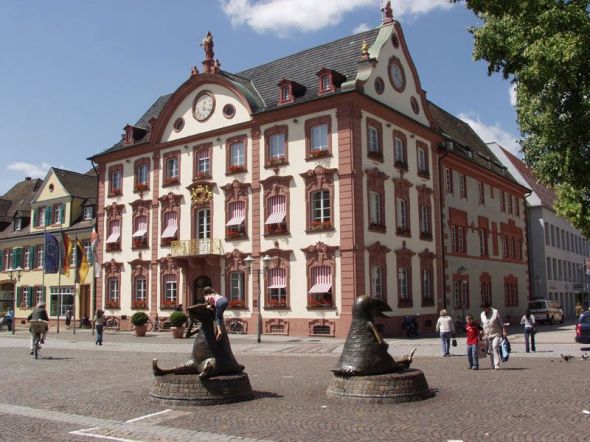
27.05.2014 ZÜRİCH/Switzerland
Venue:Haus Appenzell
Time: 20:00 h Der Abend ist eine geschlossene Veranstaltung und es sind keine Eintrittskarten erhältlich
28.05.2014 SCHAAN/Liechtenstein
Venue:TAK
Time: 20:00 h
30.05.2014 TOGGENBURG/Switzerland
Venue:KlangWelt Festival http://www.klangwelten.com/festival/
04.07.2014 MONTAFON/Austria
Venue:Montafoner Sommer 2014
Huun-Huur-Tu’s Style
Huun-Huur-Tu’s style could be best described as profoundly mysterious. This comes as a consequence of their traditional, ritual laryngeal chants descending from Central Asian land of Tuva. This unique song technique reside on developing an enthralling sound cosmos rich in undertones and overtones.
The members of Huun-Huur-Tu have devoted themselves to learning oId songs and tunes, but at the same time their performances reflect the values of globalization. The whistling of the high-mountain wind forms eerie overtones and postmodern statement. The repeated thrum of a string against wood and hide turns into a meditative, evocative figure straight from the avant-garde. The descendants of isolated Siberian herdsmen make serious, strangely universal music out of some of the planets quirkiest acoustics.
The Tuvan acoustic quartet Huun Huur Tu prove that Tuvan music can take plenty of intelligent innovation. Using traditional instruments and drawing subtly on 20th-century composers, Huun Huur Tu transform ancient songs into complex acoustic compositions.
see more:http://www.jaro.de/artists/huun-huur-tu/
THE STORY BEHİND ANCESTORS CALL
ANCESTORS
The Ene-Sai (ancient name of the Yene sei River), Sayan(mountains), and Tandim(mountains) are our ancient places.
The soft and soulful “sygyt” and “khöömei” are the ancient song of our people .
The ancestors of our “kargyraa” long ago became like gravestones on the steppe.
But among us are still people who sing kargyraa.
The ancestor of khöömei and sygyt long ago became like gravestones on the steppe.
But our hearts are proud(boil in our chest) that among us are still people who sing khöömei.
HUUN-HUUR-TU / US tour, spring 2014
Friday 04/25/2014
Cambridge, MA
First Congregational Church
11 Garden Street
Show: 8:00PM
Tix: 28
From the independent republic of Tuva, bordering Mongolia, Huun Huur Tu performs an ear-twisting vocal technique called Khöömei. In this style, a single vocalist produces two or three notes simultaneously, often a low drone along with a high-pitched whistle. Accompanied by traditional string and percussion instruments, the four-member ensemble sings rhythmic songs that capture the magic of the Siberian steppe.
see more :http://www.worldmusic.org/content/event_page/1902

